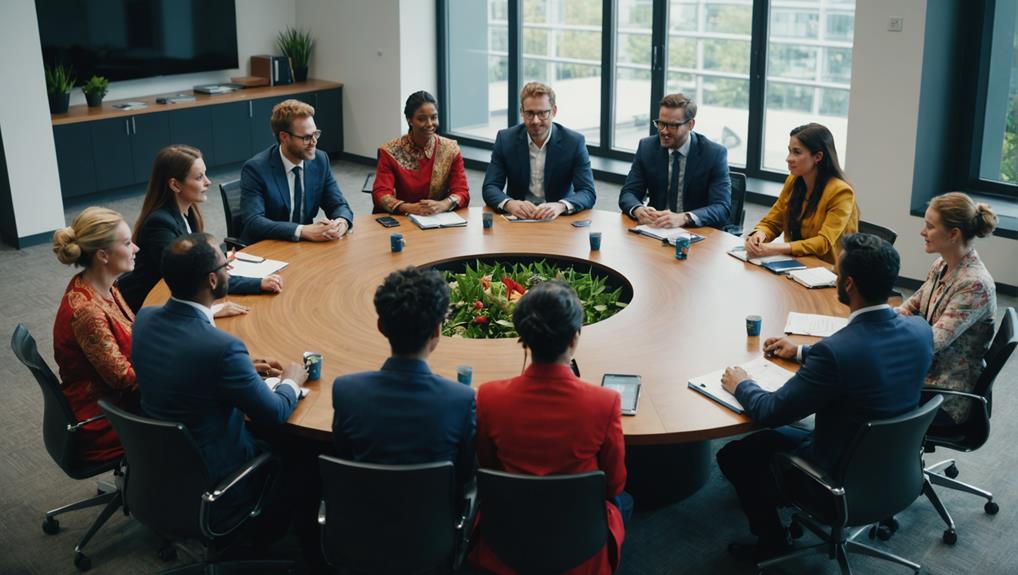Enhancing Cultural Cohesion After Mergers

After a merger, it is crucial to focus on enhancing cultural cohesion through various methods. Transparent communication is key in reducing uncertainty and building trust among employees.
Regular team meetings play a vital role in promoting collaboration and ensuring alignment on common goals. Embracing a unified vision and shared values helps create a cohesive work environment where employees feel a sense of belonging and purpose.
Encouraging open dialogue and actively seeking feedback from employees can further enhance engagement and boost morale within the organization. Implementing cross-team initiatives can help bridge gaps between different departments and promote innovation through diverse perspectives.
Celebrating milestones and recognizing achievements are also important aspects of fostering unity and solidarity among the workforce.
By consistently nurturing these elements, organizations can lay the groundwork for a successful and harmonious post-merger integration. This approach not only facilitates effective integration strategies but also contributes to a positive and cohesive work culture that benefits the entire organization in the long run.
Key Takeaways
- Promote clear communication to reduce ambiguity and build trust among employees.
- Align goals and principles to establish a cohesive vision and streamline operational methods.
- Foster open dialogues and seek input to ensure that every perspective is acknowledged and respected.
- Facilitate interdepartmental projects to dismantle barriers and encourage cooperation and creativity.
- Commemorate milestones and successes to underscore advancement and fortify team bonds.
Understanding Cultural Cohesion
Understanding cultural cohesion plays a vital role in merging companies successfully. Failure in mergers often stems from neglecting the essential cultural factors that impact daily operations and employee satisfaction. A key challenge lies in harmonizing diverse communication styles. When there's a lack of understanding of how employees from each company communicate, it can lead to misunderstandings, conflicts, and reduced productivity.
To cultivate a new integrated culture that combines the strengths of both entities, it's imperative to establish transparent communication channels. This involves not just speaking but actively listening to comprehend the core values and work approaches that drive each team. This facilitates the creation of a unified vision that resonates with everyone involved.
Furthermore, fostering connections among employees is paramount. By recognizing and celebrating achievements collectively and promoting continuous learning, strong bonds can be forged. The focus shouldn't only be on merging processes but also on nurturing an inclusive environment where every individual feels appreciated and heard.
This cohesive strategy not only improves organizational performance but also lays a solid foundation for sustained success, demonstrating that cultural cohesion isn't merely a trendy term but a critical element for post-merger integration.
Importance of Communication
Clear and open communication plays a crucial role in the success of a merger, especially when it comes to post-merger integration. It's essential to share information transparently and hold regular team meetings to ensure that everyone is on the same page. This helps in reducing uncertainty and fostering trust within the newly merged organization.
Team meetings not only serve as a platform to discuss integration progress but also promote collaboration and alignment with the shared vision of the merged entity.
In mergers and acquisitions, cultural alignment is a key factor for successful integration. By maintaining clear communication channels and holding regular discussions, organizations can bridge the gap between different corporate cultures. This alignment fosters a sense of unity and common purpose among employees from both entities, leading to a smoother transition and better overall performance post-merger.
Transparent Information Sharing
Transparent sharing of information is crucial for the success of mergers and acquisitions, as it fosters trust and maintains employee engagement throughout the integration process. Prioritizing clear communication and transparency creates a secure and valued environment for employees. Research shows that 86% of employees highly appreciate transparency, especially during periods of uncertainty like mergers. This open communication not only reduces anxiety but also significantly impacts employee retention and the successful integration of company cultures.
Effective communication plays a vital role in retaining top talent within our organization. Without it, studies suggest that 42% of employees are more likely to consider leaving, which can have a detrimental effect on our overall performance. By openly sharing information, we can mitigate the high stress levels experienced by 33% of employees due to a lack of communication during mergers. This transparency contributes to a smoother blending of different company cultures, ultimately enhancing productivity and boosting morale.
To visually depict the benefits of transparent information sharing, consider the following table:
| Advantages | Statistics | Impact |
|---|---|---|
| Trust and Engagement | 86% value transparency | Cultivates a secure and valued work culture |
| Employee Retention | 42% may leave without communication | Retains top talent, reduces turnover |
| Stress Reduction | 33% experience high stress | Decreases anxiety, improves morale |
Embracing transparent information sharing is a strategic decision that can significantly strengthen our organization's cultural cohesion post-merger.
Regular Team Meetings
Frequent team meetings play a vital role in fostering communication and alignment following a merger. Consistent gatherings create a space for open dialogue, ensuring that all team members are kept in the loop and actively engaged in the integration process. This practice is crucial for building a foundation of trust and collaboration within our newly combined teams.
Regular meetings serve as a platform for sharing updates, addressing concerns, and celebrating achievements collectively. These interactions are instrumental in strengthening relationships, fostering unity, and promoting transparent communication among team members. By coming together on a regular basis, we reinforce our shared vision and values, ensuring a cohesive approach moving forward.
Maintaining alignment on goals and expectations is a primary focus of these team meetings. This alignment is essential for propelling the organization forward in a unified manner. Effective communication during these gatherings not only disseminates important information but also encourages active engagement, nurturing a culture of innovation and continuous improvement within the merged teams.
Aligning Vision and Values

Cultivating a cohesive and engaged workforce post-merger hinges on aligning vision and values. Bringing together teams from diverse organizational cultures goes beyond just merging businesses; it entails forging a new entity with a collective purpose.
This fresh cultural amalgamation necessitates a harmonized vision and values to steer us forward. Consistency in these aspects not only streamlines work methods but also fosters a sense of unity among all team members.
A shared vision and values play a pivotal role in sustaining team motivation and alignment post-merger. While differing decision-making styles may present obstacles, strategic alignment efforts can surmount these challenges.
Clear and frequent communication regarding our new direction is crucial to ensuring that each team member comprehends and embraces the organizational goals.
Promoting Open Dialogue
To foster open dialogue following mergers, it's crucial to promote transparent communication and encourage inclusive conversations.
By prioritizing honesty and openness, trust is built, ensuring that all individuals feel respected and listened to.
This approach not only helps in aligning cultural values but also facilitates the integration process, leading to improved collaboration and teamwork throughout the organization.
Encouraging Transparent Communication
To build trust and alignment after a merger, we must prioritize clear communication by fostering open dialogue among all team members. Transparent communication is fundamental for successful integration, serving as the foundation for our collective vision. By ensuring that everyone feels heard and informed, we can reduce uncertainties and strengthen our unity.
Open dialogue plays a crucial role for several reasons:
- Sharing Information: It helps us effectively disseminate essential information, ensuring everyone is well-informed.
- Addressing Concerns: Providing a platform for team members to voice their concerns allows us to tackle issues proactively.
- Generating Ideas: Encouraging team members to share their ideas promotes innovation and collaboration, propelling our company forward.
By actively encouraging open dialogue, we cultivate a culture of trust and alignment. Clear communication channels enable us to address rumors, minimize uncertainties, and foster a sense of togetherness. This not only ensures that all team members are engaged and informed but also cultivates understanding, empathy, and a shared vision.
Ultimately, transparent communication is the linchpin for successful cultural integration post-merger, creating a more cohesive and collaborative environment where everyone feels valued and aligned with our goals.
Fostering Inclusive Conversations
In the realm of mergers and acquisitions, the seamless integration of cultures is paramount for success. Embracing transparent communication sets the stage for inclusive conversations that ensure every team member feels valued and heard. This approach not only fosters engagement but also drives productivity, a critical factor in post-merger integration.
Research indicates that companies that prioritize open dialogue after a merger experience a significant 20% boost in productivity. This increase is attributed to the active participation and collaboration that arise when diverse perspectives are welcomed and respected. By creating a culture of open communication, organizations can navigate the complexities of merging entities more effectively.
Moreover, when employees perceive that their voices are acknowledged and valued, morale receives a substantial boost. Reports indicate that 90% of employees feel a greater sense of worth when they believe their opinions are respected. This feeling of value is instrumental in maintaining engagement and motivation throughout the often turbulent post-merger integration phase.
Seeking and Utilizing Feedback

Collecting feedback from employees following a merger provides valuable insights into areas that require improvement and opportunities to promote cultural cohesion. By utilizing employee surveys and other feedback methods, we can identify the strengths and weaknesses of the integration process. This crucial approach not only uncovers potential issues but also reveals ways to enhance our cultural unity.
When we actively seek and incorporate feedback, we show a sincere dedication to understanding our team's experiences and viewpoints. This practice can result in:
- Heightened engagement: Employees feel appreciated when their opinions are acknowledged and their feedback is taken into account.
- Improved satisfaction: Tackling concerns directly can boost overall morale and workplace happiness.
- Enhanced cultural alignment: Detecting discrepancies early on enables us to implement strategic measures that promote harmony and inclusivity.
Making changes based on this feedback is essential. Merely listening is insufficient; we must take action. By doing so, we establish an environment where employees witness concrete proof of our commitment to their well-being. This, in turn, can foster greater engagement and satisfaction, ultimately leading to a more cohesive and united organizational culture.
Integrating Cross-Team Initiatives
Integrating cross-team initiatives is crucial for cultivating collaboration and trust among employees with diverse backgrounds in a merged organization. By blending these initiatives, we can bridge the cultural variances that often arise post-merger.
Collaborative projects and joint task forces serve as potent instruments for promoting integration and knowledge sharing among teams. They inspire employees to work together beyond their usual circles, fostering opportunities for innovative solutions and fresh perspectives.
Encouraging cross-team initiatives breaks down silos and enhances communication across different departments. When aiming for common objectives, we nurture a sense of unity and shared purpose critical for a successful merger.
Training programs tailored to address cultural disparities can further bolster these initiatives, ensuring everyone is aligned and boosting the overall efficiency of the merged entity.
Integrating cross-team initiatives expedites cultural cohesion and alignment within the newly formed organization. This not only enhances teamwork but also establishes an inclusive environment where every team member feels valued and understood.
Such an approach not only boosts morale but also drives productivity and fosters innovation. Let's prioritize making cross-team initiatives a cornerstone of our strategy, paving the way for a more harmonious and prosperous merged organization.
Empowering Employee Contributions

Encouraging diverse perspectives and recognizing individual strengths is crucial in empowering employee contributions following a merger.
By actively soliciting input from all team members, we create an environment that nurtures innovation and ensures every voice is valued.
This inclusive approach not only boosts morale but also cultivates a more robust, unified culture that benefits the entire organization.
Encouraging Diverse Perspectives
Embracing a multitude of perspectives ensures that our decision-making process benefits from a wide array of viewpoints. Encouraging diverse perspectives post-merger is crucial for cultivating a culture of innovation and creativity. By empowering employees to contribute their unique insights, we can establish an environment where everyone feels valued and motivated to actively participate in propelling the company forward.
Diverse perspectives not only enhance our decision-making processes but also boost our problem-solving capabilities and overall performance. When employees witness their distinct viewpoints being taken into consideration, they become more engaged and dedicated, fostering a stronger sense of unity and belonging following the merger.
To underscore the significance of diverse perspectives, consider the following points:
- Innovation: Varied perspectives spark creativity, leading to novel solutions that may not arise in a uniform setting.
- Engagement: Employees who believe their input is valued are more likely to be proactive and committed.
- Performance: A range of viewpoints contributes to more effective problem-solving and decision-making, resulting in better outcomes for the organization.
Encouraging diverse perspectives isn't merely a tactic; it's an essential component for thriving in today's ever-evolving business landscape. Let's embrace this approach to ensure that our merged organization achieves its full potential.
Recognizing Individual Strengths
Recognizing and harnessing individual strengths is crucial for empowering employees and boosting team performance post-merger. By appreciating and leveraging the diverse skills and talents that each team member possesses, we can cultivate an inclusive culture that fosters collaboration and sparks innovation.
Empowering employees through the recognition of their unique strengths not only elevates morale but also amplifies overall team productivity. This approach motivates individuals to make meaningful contributions, feeling valued and essential to the team's success.
When we acknowledge and leverage various strengths within the team, we can observe significant enhancements in team performance. For instance, individuals with technical expertise bring specialized knowledge that increases efficiency and problem-solving capabilities. Creative thinkers provide innovative solutions that drive product development and strategic initiatives forward. Leaders with strong leadership skills can guide and inspire others, improving team cohesion and direction. Effective communicators facilitate clear exchanges of ideas, leading to enhanced clarity and reduced misunderstandings within the team.
Fostering Trust and Collaboration
To build trust and collaboration post-merger, we need to focus on open communication and mutual respect among all team members. Combining two unique corporate cultures requires a proactive approach to address potential conflicts and misunderstandings. By establishing trust and creating an inclusive environment where everyone feels valued, we can strengthen relationships and boost overall productivity.
Our approach should include:
- Clear Communication: Regular updates and honest dialogue help dispel rumors and reduce uncertainty.
- Inclusive Decision-Making: Involving employees in problem-solving and decision-making processes ensures that everyone feels a sense of ownership and responsibility.
- Collaborative Projects: Encouraging cross-functional teams to work together on innovative projects bridges cultural gaps and promotes unity.
Trust is crucial for effective communication, problem-solving, and decision-making. When team members trust each other, they're more likely to share ideas and collaborate, which drives innovation and success. Addressing concerns proactively and acknowledging the contributions of all team members will help maintain high levels of engagement and reduce turnover rates.
Embracing Organizational Diversity

To drive creativity and innovation in the post-merger landscape, we must harness our diverse backgrounds actively. Organizational diversity plays a crucial role in enhancing problem-solving abilities and adapting to evolving market conditions. By integrating a variety of perspectives, we create an environment ripe for groundbreaking ideas and solutions that can give us a competitive edge.
Creating an inclusive and welcoming work environment through effective cultural integration strategies is key. Every team member should feel valued and respected, irrespective of their background. This approach not only boosts employee engagement but also bolsters retention rates, which are pivotal post-merger.
Here's a brief summary of the advantages of embracing organizational diversity:
- Boosted Creativity: Diverse teams yield a wealth of innovative ideas.
- Improved Problem-Solving: Multiple perspectives lead to more effective solutions.
- Enhanced Adaptability: Diverse insights facilitate navigating market changes.
Celebrating Unified Workforce
Celebrating our unified workforce following a merger can significantly boost team morale and foster a strong sense of belonging among employees. Recognizing our collective accomplishments and milestones goes beyond just lifting spirits; it actively reinforces our shared vision and values, aligning everyone towards common objectives. Publicly acknowledging these successes helps solidify the sense of unity and collaboration that's essential for a cohesive work environment.
To enhance this celebratory atmosphere, we should focus on a few key areas:
- Milestone Celebrations: Commemorating important integration milestones through events or public announcements can reinforce our progress and shared vision.
- Positive Feedback: Continuously highlighting positive feedback from customers and acknowledging employee achievements can create a culture of encouragement and motivation.
- Strategic Alignment: Aligning our strategic goals with cultural celebrations helps cement the merged company's identity and ensures everyone is moving in the same direction.
Frequently Asked Questions
How to Overcome Cultural Differences in Mergers and Acquisitions?
To overcome cultural differences in mergers and acquisitions, it is crucial to focus on aligning leadership, fostering effective communication strategies, and emphasizing employee engagement. By prioritizing these key areas, organizations can ensure a smooth integration of diverse cultures post-merger. Change management practices and a commitment to continuous innovation play a vital role in navigating the complexities of cultural differences and successfully merging two distinct organizational cultures.
Cultural alignment in mergers and acquisitions is a strategic process that requires a deep understanding of the values, beliefs, and norms of each organization involved. By proactively addressing cultural differences and finding common ground, companies can create a cohesive and harmonious work environment for employees from both sides of the merger. This not only enhances collaboration and teamwork but also boosts employee morale and productivity.
Effective communication is essential in bridging the gap between cultures during mergers and acquisitions. Clear and transparent communication channels help in building trust and fostering open dialogue among employees. By keeping all stakeholders informed and engaged throughout the integration process, organizations can prevent misunderstandings and conflicts that may arise due to cultural differences. Additionally, regular feedback mechanisms and listening sessions can provide valuable insights into the cultural dynamics at play and help in addressing any issues promptly.
Employee engagement is a critical factor in successfully integrating diverse cultures post-merger. By involving employees in the integration process, organizations can leverage their diverse perspectives and experiences to create a more inclusive and collaborative work environment. Encouraging participation in cross-cultural training programs, team-building activities, and cultural exchange initiatives can help employees appreciate and respect each other's differences. This, in turn, fosters a sense of belonging and unity among employees from different cultural backgrounds, ultimately leading to a more cohesive and integrated organization.
How Do You Integrate Cultures in a Merger?
Integrating cultures in a merger begins with aligning leadership and implementing strong communication strategies. It is essential to conduct a comprehensive cultural assessment to understand the differences and similarities between the two organizations. By prioritizing employee engagement and utilizing innovative approaches, such as team-building activities and cross-functional projects, we can foster cohesion and collaboration across teams.
In mergers and acquisitions (M&A), cultural alignment is crucial for the long-term success of the integration process. Research has shown that companies that focus on integrating cultures effectively are more likely to achieve their strategic objectives and financial goals post-merger. By proactively addressing cultural differences and creating a shared vision, organizations can create a strong foundation for a successful integration.
One effective way to integrate cultures in a merger is to involve employees from both organizations in the process. By soliciting feedback, listening to concerns, and involving employees in decision-making, organizations can create a sense of ownership and commitment to the new culture. This approach not only helps to build trust and transparency but also ensures that employees feel valued and respected throughout the integration process.
How Do You Build Culture After Acquisition?
To build culture after acquisition, we focus on ensuring that leadership is in sync, implementing a strong communication plan, and enhancing employee involvement. Our cutting-edge training initiatives help all individuals seamlessly adjust, cultivating a cohesive and forward-looking organizational atmosphere.
By prioritizing leadership alignment, we set the tone for a unified culture that promotes collaboration and innovation. Effective communication strategies are key to keeping everyone informed and engaged throughout the integration process. Boosting employee engagement fosters a sense of belonging and commitment, driving productivity and morale within the newly merged entity.
Our innovative training programs are designed to facilitate a smooth transition and foster a culture of continuous learning and development. This approach helps to bridge any gaps between the merging organizations, creating a shared vision and values that guide the new entity forward. With a focus on cultural alignment and integration, we lay the foundation for a successful post-merger integration that maximizes the strengths of both companies and drives sustainable growth.
How Does Culture Play Role in the Transition of a Company Through Any Change Like Merger?
To ensure a seamless integration during a merger, we must prioritize aligning leadership, implementing effective communication strategies, and enhancing employee engagement within our change management framework. By focusing on these key areas, we can drive innovation and successfully navigate cultural shifts that arise during the post-merger integration process.
Leadership alignment is crucial in setting the tone for the new organization formed after a merger. When top executives are on the same page and demonstrate unity in decision-making and strategic direction, employees are more likely to feel a sense of stability and direction. This can help alleviate uncertainties and anxieties that often accompany organizational changes.
Effective communication plays a vital role in keeping all stakeholders informed and engaged throughout the merger process. Clear and transparent communication channels help foster trust and mitigate misunderstandings that can arise due to cultural differences between merging entities. By ensuring that information flows freely and openly, we can create a more cohesive and collaborative work environment post-merger.
Boosting employee engagement is essential for retaining talent and driving motivation during times of change. Engaged employees are more likely to adapt to new cultural norms and embrace the shared values of the merged organization. By providing opportunities for staff to voice their concerns, participate in decision-making processes, and contribute their unique perspectives, we can create a more inclusive and dynamic workplace culture.
Conclusion
We've covered the key steps to enhance cultural cohesion post-merger. Prioritizing communication, aligning our vision and values, and fostering open dialogue are crucial in bridging any gaps.
Seeking feedback, empowering employees, and celebrating diversity are vital for building trust and collaboration.
Let's come together as a unified workforce, implementing these strategies to create a robust organizational culture that thrives on mutual respect and shared objectives.
By working collectively, we can achieve a harmonious and prosperous merger.
